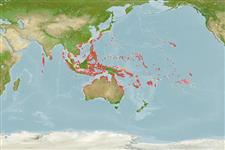Actinopterygii (ray-finned fishes) >
Anguilliformes (Eels and morays) >
Muraenidae (Moray eels) > Muraeninae
Etymology: Gymnothorax: Greek, gymnos = naked + Greek, thorax, -akos = breast (Ref. 45335).
Environment / Climate / Range
Ecology
Marine; reef-associated; depth range 0 - 30 m (Ref. 86942), usually 0 - 4 m (Ref. 90102). Tropical, preferred ?; 36°N - 33°S, 70°E - 130°W
Indo-Pacific: Christmas Island to French Polynesia, north to the Ryukyu Islands and south to Tonga; throughout Micronesia.
Size / Weight / Age
Maturity: Lm ? range ? - ? cm
Max length : 66.0 cm TL male/unsexed; (Ref. 90102); common length : 40.0 cm TL male/unsexed; (Ref. 2334)
Vertebrae: 125 - 137. Vomerine teeth are biserial and diverging anteriorly with the posterior most 3 to 4 teeth forming a single row (Ref. 37816).
Fairly common inhabitant of reef flats where it is usually encountered in shallow tidal pools. Feeds on crustaceans, small fishes and octopi (Ref. 89972). Often in shipwrecks; usually in pairs or small aggregations, and shares habitat with other morays (Ref. 48635). Also common in sheltered reefs (Ref 90102).
Life cycle and mating behavior
Maturity | Reproduction | Spawning | Eggs | Fecundity | Larvae
Simultaneous hermaphroditism not confirmed (Ref. 84746).
Böhlke, E.B., J.E. McCosker and D.G. Smith, 1999. Muraenidae. p. 1643-1657. In K.E. Carpenter and V.H. Niem (eds.) FAO species identification guide for fishery purposes. The living marine resources of the Western Central Pacific. Vol. 3. Batoid fishes, chimaeras and bony fishes part 1 (Elopidae to Linophrynidae). FAO, Rome. (Ref. 12904)
IUCN Red List Status (Ref. 115185)
CITES (Ref. 94142)
Not Evaluated
Threat to humans
Harmless
Human uses
More information
ReferencesAquacultureAquaculture profileStrainsGeneticsAllele frequenciesHeritabilityDiseasesProcessingMass conversion
Tools
Special reports
Download XML
Internet sources
